Have you always wanted chickens? Do you live in town and pine away for country life so you can get a few hens and produce your own farm fresh eggs? It may come as a surprise to some of you to hear that YOU CAN! An urban chicken revolution is sweeping across the nation, and city folks all over the place are gathering farm fresh eggs right in their own backyard. Chicken lovers tend to flock together, so I know quite a handful of urban chicken revolutionaries here in my community. And, you know what else? They LOVE to talk about their chickens. So, I have here a collection of interviews on a variety of urban chicken coops and flocks to inspire the small farmer in you to take action!
Chickens in a family’s organic backyard garden
My friend Jeana, mother of three, faithful reader of Mother Earth News, and organic backyard gardener, found a snazzy coop on wheels design on the internet and set to work building one of the fanciest coops from scratch I’ve seen yet. Her children love the new family pets, and they are looking forward to fresh eggs this fall!
The economic crisis hit us pretty hard and organic eggs were no longer a part of our budget. By having our own chickens, we can provide food for our family and feel confident that our meticulous care of the chickens would provide us with good quality organic eggs.
2. Tell us about your urban coop design.
I went through several designs on the internet. Finally, I found the one that I found the most aesthetically pleasing. I made a cardboard model and came up with my own measurements using standard size siding and plywood sheets.
3. How many eggs do you generally get every day? Seasonally?
We have raised our chickens from chicks and they should be of age to lay in the fall of this year.
4. What breeds of hens do you have? What are their names?
We have a speckled sussex named Silvermist, a production red named Martha and a black australorp named Chocolate.
5. How much work is it for you to keep chickens?
Organic chicken feed is $23 per bag and it looks like it will last 4 to 6 months. The pine bedding is $5 per bag and I use a bag a month. On average, I will be spending $106 per year and the cost I would have spent (1 dozen eggs per week $5 x 52 weeks = $260 per year) in store bought organic eggs is $260.
6. What is your favorite thing about your chickens?
I could sit and watch them forever. They are quiet and having 3 hens raised from chicks, they are very close yet squabble like my children. They eat my weeds and bugs.
7. What words of encouragement would you like to share with would-be urban chicken keepers out there?
Chickens are great composters, they are quiet and they don’t smell when cared for properly. It’s a win-win.
Chickens in a city park learnscape
Erin and Joy Lamb, park hosts for Nearby Nature in Alton Baker Park, have incorporated chickens in the Learnscape. What you might be wondering, is a learnscape? According to the Nearby Nature website, “Our Learnscape is a model for sustainable living practices as well as an outdoor classroom. We’ve created user-friendly composting areas and a landscape that facilitates energy and water conservation. We’ve planted gardens that produce food as well as awaken the senses. We’ve also created nature-themed artwork, outdoor classrooms (the Nest, River Run, and the Edible Schoolyard), and natural playspaces for kids. Our Learnscape inspires curiosity, imagination, and stewardship.”
1. What made you decide that you needed chickens in your life?
I was a vegetarian until I needed more protein during pregnancy and started raising meat and egg chickens.
2. Tell us about your urban coop design.
A space to throw them our scraps easily. Roof. Dark nesting place. Uses both recycled and purchased materials.
3. How many eggs do you generally get every day? Seasonally?
2-3 every three days per hen, towards 3 in summer, towards 2 in winter.
4. What breeds of hens do you have? What are their names?
now we have several breeds, including araucanas, light brahmas, rhode island reds, maran. They have lots of names (we have 27 chicks right now), including summer and fall for the grown rhodies, rose, sunflower, hawk, jumpy, calmy, and beaker.
5. How much work is it for you to keep chickens?
it’s an everyday commitment to make sure they have food, water and a safe and clean place to live. We can give them extra food and water and hope that nothing follows them into the coop if we want to leave for a couple of days. Other than that, we get a house-sitter.
6. What is your favorite thing about your chickens?
They’re fun to watch, we love having eggs w/o having to go shopping, the kids love to gather the eggs. My seven-year-old likes to go out in the morning, gather eggs, and make fried eggs for the family. They eat weeds, slugs and snails. They’re pretty out in the yard. Eggs are beautiful. They make great compost for my garden – I use fresh manure to compost quack grass b/c it’s so high in nitrogen.
7. What words of encouragement would you like to share with would-be urban chicken keepers out there?
Make sure to dig your fence into the ground to prevent night-time marauders and dogs. Enjoy closing the loop in your gardening. Time invested up front in a good coop will pay off for a long time. The joy of vari-colored eggs is hard to beat, whether you have kids or not.
Chickens in an urban permaculture homestead
Min Yi and Cameron have turned their urban lot into bountiful gardens, one bed at a time. At one point they had many chickens in their large chicken run and gazebo-turned-coop, along with the meat rabbits in their yard. Now they just have enough chickens for their own family’s eggs. If you are interested in their business, From Lawn to Lunch, click on the link to check it out!
1. What made you decide that you needed chickens in your life?
We wanted practical pets, perhaps it’s my immigrant mentality. Chickens make eggs, till the earth, compose food into fertilizer and entertain guests. All these perks are well worth the chicken feed and space in the yard.
2. Tell us about your urban coop design.
We simply converted our gazebo into the chicken coop. When we had 4 chickens, their coop was a dog house. They’re simple folk and only want fresh water, food, fresh greens, a place to scratch, perch and run around in.
3. How many eggs do you generally get every day? Seasonally?
3-5 in the summer, 1-3 in the winter (many of them are getting on in old age)
4. What breeds of hens do you have? What are their names?
Beaky Buff O, Nova winedot, Chai rhode island red, Fung and Buddhist Americanas, Kiwi (the little one’s type escapes me, they are tiny), Sunrise sexlink
5. How much work is it for you to keep chickens?
gather eggs daily or every two days, change water every other day, monitor food supply, feed them weeds and slugs/snails I find, shovel their compose for garden use twice a year. It’s all too easy.
6. What is your favorite thing about your chickens?
Do I have to pick one?
7. What words of encouragement would you like to share with would-be urban chicken keepers out there?
Once you get started you’ll realize how amazing they are and how easy they are to have in your yard. We are in good relations with our neighbors because of our chickens. Our yard is alive because of them. They are great listeners too, who needs therapy when you have chickens?
Chickens in a Family’s Backyard Oasis
My wonderful former neighbor, Phaedra, who’s family got us going with our own urban chicken coop before we moved out to the country (our chicken coops were right across the fence from each other!), has a private backyard oasis surrounded by lush green bamboo, with a huge garden, a deluxe treehouse, and an adorable chicken coop made from an old playhouse. The chickens scratch and cluck the day away in their large chicken run in the back of the yard.
1. What made you decide that you needed chickens in your life?
We realized after doing some reading that they really aren’t that hard to keep. We got tired of buying runny, flat yolked eggs at the store. It feels healthier for our family to know where our eggs are coming from and that we are not supporting mass chicken farms.
2. Tell us about your urban coop design
Well, our coop is actually a wooden kids playhouse. We customized the inside with roosting areas and nesting boxes which you can also access from the back of the coop.
3. How many eggs do you generally get every day? Seasonally?
We have four chickens. We usually get 3-4 eggs per day. During the winter we have a light with a timer that will provide 16 hrs of “light” which helps with laying year round. We do however, give them a break from it at some point in the winter, but we sure miss our yummy eggs when we do.
4. What breeds of hens do you have? What are their names?
We have one Rhode Island – “Poppy.” 2 Araucana – “Rubita” and “Negrita.” 1 Wyandotte “Puffy Cheeks” or “PC” for short.
5. How much work is it for you to keep chickens?
Not much work at all. Changing their water and filling up their food container is a weekly but easy chore. Cleaning their coop is a bit more work, but usually only a monthly event.
6. What is your favorite thing about your chickens?
Apart from the obvious- the wonderful fresh eggs, we also enjoy visiting with them. Getting to know their different personalities and being able to dispose of food waste knowing that every last morsel will be eaten. Also after cleaning their coop you can use their waste in your garden as fertilizer. They eat lots of bugs and slugs, too.
7. What words of encouragement would you like to share with would-be urban chicken keepers out there?
Do it! Once you become an urban chicken keeper you will never want to stop. You won’t have any problems getting chicken-sitters if you offer their eggs in exchange. It is easier, cheaper and less work than pets such as dogs and cats, not to mention that they don’t lay eggs. Hooray for fresh huevos!
Chickens in a Waldorf preschool garden
At the Mother Tree, an in-home Waldorf preschool run by my friend, Carolina Allen, the chickens and one duck live in a portable chicken tractor and roam around her yard, which is reminiscent of a magical English countryside cottage garden. In the dappled shade of the giant cottonwood tree, happy chickens and children alike run about through the flowers.
1. What made you decide that you needed chickens in your life?
I run a small Waldorf Preschool and Day care and felt that Chickens would enhance their appreciation and experience of the natural world- provide them eggs which for the little children are like finding buried treasure everyday not to mention that in this day and age of quick food and such- its a great family chore for my own children to care for the chickens…and benefit from the work with real honest to goodness appreciation for the fresh eggs. We bake our own bread each week as well for the same reason- Its just hard these days to build in gratitude and have an honest appreciation for labor for youth today and these were two things I could easily do for my children and all the ones that I care for and teach.
2. Tell us about your urban coop design.
I saw the design on Craig’s List and thought it was beautiful and practical and the fellow who made it offered me ( Since I was one of his first customers) a nice deal on his first experimental design and thus here it is. Its great- has a few glitches because it was his first one but made this way without the glitches would be a wonderful coop. He has since moved to Indiana however so anyone who wants to take a closer look on how its made is quite welcome to come on by.
3. How many eggs do you generally get every day? Seasonally?
Sadly, one of our chickens ( Midnight One- Eye)eats her eggs. She is quite the pirate and lives up to her name on many levels which keeps life around here full of laughter so I can ‘t quite consign her to chicken broth land yet… but… it is a bit of a challenge to get our full complement of 5-6 eggs a day with her around. Luckily the other chickens have taken to hiding their eggs from her so we still do seem to have anywhere from 3-5 a day, depending.
4. What breeds of hens do you have? What are their names?
I can’t remember their breeds but their names are Midnight One Eye, Sunrise, Daphne, Snowflake, Rose, Sassafras Dapple-Dust, and Honey-Marmalade-Rose. ( My children have a penchant for first, second and last names. ) We also have Duck (who needs a companion quite desperately and I am hoping those who read this article might know of someone with an extra young duck who could be her friend..). Ducks name is Sillyfoot and she is of a breed which lays lots of eggs as well. Ducks are actually almost as prolific as Chickens when it comes to egg laying-they live for 20 years and have so much personality that I recommend them almost more than chickens. Ours comes in and sleeps in the bathtub at night and likes hot showers! You can actually buy Duck Diapers on line to help support their inquisitive love and loyalty to their family. We haven’t tired that yet but– we may yet!
5. How much work is it for you to keep chickens?
The only tricky thing is making sure they are in at night fall- if we go out than they may not get put away till late which means they are at risk to being marauded by the local raccoon goons.
6. What is your favorite thing about your chickens?
The fact that they like coming up to the window to see what we are doing inside… they are very curious and interested in all our doings and that’s just — funny.
7. What words of encouragement would you like to share with would-be urban chicken keepers out there?
Its not nearly as difficult or challenging as you may imagine-when once you begin- its really quite easy and seems to fit into the busyness of life very naturally.I do recommend a long or large run for them during the growing season so they don’t eat up all the starts however.
More Chickens in a Family’s Backyard Organic Garden
Tamara and Patrick’s backyard is an amazing example of urban farming. They grow their own hops, thornless blackberries, strawberries, tomatoes, and winter crops like kale and carrots from which they feed their family well all year long. Their chickens scratch and peck in the shade of a huge thornless blackberry bush that also benefits from all the manure at its roots.
It was a neighborhood epidemic…and we’d worked on a farm with fresh eggs and couldn’t go back.
2. Tell us about your urban coop design.
Part of an old shed, up on 4X4 stilts, surrounded by a sturdy covered enclosure.
3. How many eggs do you generally get every day? Seasonally?
3-5, most of the year
4. What breeds of hens do you have? What are their names?
Nameless, 2 black austrulorps, an americauna, and 2 brown leghorns
5. How much work is it for you to keep chickens?
Regular cleaning of run in urban area is a monthly job, all else pretty mellow.
6. What is your favorite thing about your chickens?
Eggs and slug patrol!
7. What words of encouragement would you like to share with would-be urban chicken keepers out there?
It’s easier than you think.
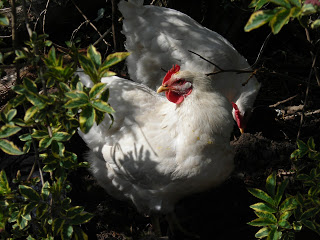
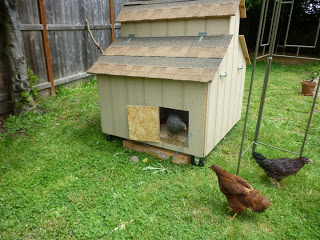
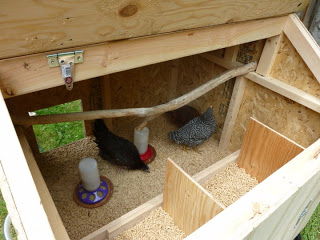
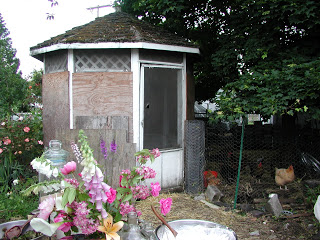

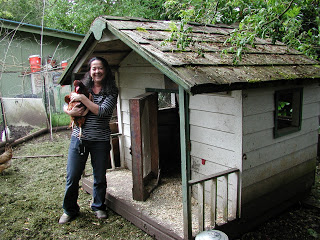
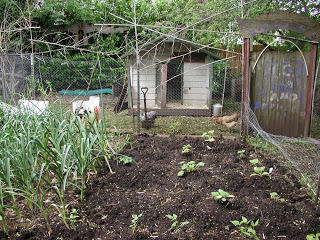


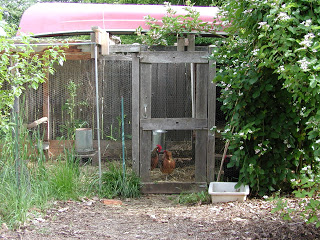
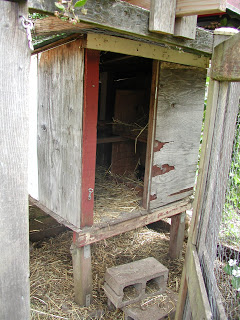
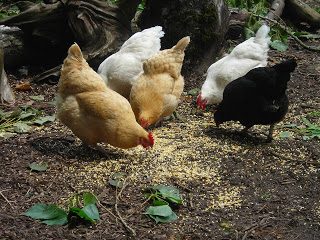
Leave a Reply